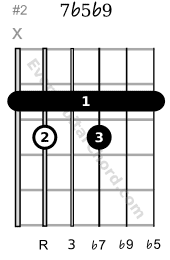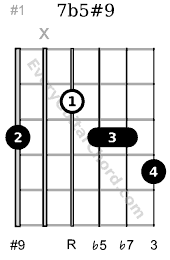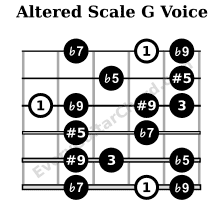What is a 7b5 7b1 Feed
Dominant 7b5 chords are harsh and difficult to know how to use when you first encounter them. You can use the various 7b5 chords in place of dominant 7th (V7) chords, but it's more common to see then as leading tone chords of the melodic minor or as tritone substitutions. I cover all nine 7b5 chords in detail, the scales and modes that build them and go over the ways that you can use them in your songs.
7b5 chords, scales & modes in music
The diminished 5th interval, otherwise known as the trione, is the basis for 7b5 chords. A dominant 7b5 chord is the same as a dominant 7th (7, 9, 13, 7♭9, 7#9, etc.) except the perfect 5th is lowered by a semitone. Read my Music Intervals article if you are unfamiliar with intervals, specifically the diminished fifth or tritone interval.
You can view all b5 chords as built on the Maj ♭5 chord, though I've only seen that chord in one song – Great Gig in the Sky by Pink Floyd. But first, let's look at the tritone, the Maj ♭5 and maj7♭5 chords before diving into the dominant 7♭5 chords.
Tritone interval & Tritone substitution
The tritone is a unique interval. It is the only interval that inverts to itself. All other intervals invert to their corresponding opposite. An interval inversion is when you take the lower note and raise it by an octave making it the 2nd note of an interval.
Let's pick the intervals of a 3rd and 6th and compare it to the diminished 5th (tritone) interval.
C major scale: C-D-E-F-G-B-C
C to E is a major 3rd (M3) and it inverts to E to C which is a minor 6th (m6) interval.
A to C is a minor 3rd (m3) and it inverts to C to A which is a major 6th (M6) interval.
The tritone in the key of C major is between the notes F and B. If you invert that interval to B and F then it is still a tritone. Hopefully, you notice those two notes are in the dominant 7th chord for C major, G7.
A tritone substitution for a G7 chord is D♭7, the dominant 7th chord a tritone away from the note G. D♭7 does resolve to a C major chord, but the tendency to resolve to C is stronger when it has altered chord tones: ♭9, #9, ♭5, #5, etc.
The major b5 chord and related chords
The major b5 chord is not really a chord or at least one I would never bother using. However, it is the base chord for every 7b5 chord so it's a good idea to take a look at it before moving to the dominant 7b5 chords.
Lydian sounding major b5 chords
The notes and intervals in the Maj ♭5 chord are found in all 7b5 chords, and the maj7b5 chord is a common Lydian chord though the maj7##11 is more common.
Maj ♭5 chord
Chord intervals: root, major 3rd, diminished 5th = 1-M3-d5 = 1-3-♭5
Chord tendency: works best as a Lydian chord, e.g. Fmaj ♭5 (F-A-B) > C
maj7♭5 chord
Chord intervals: root, major 3rd, diminished 5th, major 7th = 1-M3-d5-M7 = 1-3-♭5-7
Chord tendency: Another Lydian chord, Fmaj7♭5 (F-A-B-E) > C
So those two are Lydian type ♭5 chords but they are not the focus of this article. I just wanted to introduce you to those possible chords in case you ever encounter them. By the way, the add#11 is a better choice than the Maj ♭5 chord.
Dominant 7b5, 9b5 & 13b5 chords
The following 3 chords are similar to the dominant 7, 9 and 13 chords but they obviously have a diminished 5th rather than a perfect fifth. The 7b5 is the most common and it sounds pretty good. I also like the 13b5 chord but the 9b5 is too nasty for me.
Here is a chart that describes the symbols on my chord and scale diagrams:

7b5 chord
Chord intervals: root, major 3rd, diminished 5th, minor 7th = 1-M3-d5-m7 = 1-3-♭5-♭7
Equivalent chord: equals 7♭5 on the ♭5, G7♭5 = D♭7♭5 (symmetrical chord)
Chord tendency: resolves to the ♭9, 4, 5 and M7 but also to the ♭5, G7♭5 > A♭, C, D, F#, and D♭


I marked both the root and flat 5th white because either one can be the root of the chord.
9♭5 chord
Chord intervals: Root, major 3rd, diminished 5th, minor 7th, major 2nd = 1-M3-d5-m7-M2 = 1-3-♭5-♭7-9
Equivalent chord: equals 7♭5♭13 on the ♭5, and 9#5 on the 9, G9♭5 = D♭7♭5♭13 = A9#5
Chord tendency: same as 7♭5 but also to every chromatic major chord except the M3 and m6, so no B or E♭ for G.


13♭5 chord
Chord intervals: Root, major 3rd, diminished 5th, minor 7th, major 6th = 1-M3-d5-m7-M6 = 1-3-♭5-♭7-13
Equivalent chord: equals 7♭5#9 on the ♭5, G13♭5 = D♭7♭5#9
Chord tendency: same as 7♭5 but also the ♭7


Dominant 7b5 chords with altered extensions
Here are 6 more 7b5 chords but with either a ♭9, #9, ♭13. or 13 interval added The 9♭5♭13 and 13♭5#9 are interesting chords in that they are composed of 3 different tritone intervals.
7♭5♭9 chord
Chord intervals: root, major 3rd, diminished 5th, minor 7th, minor 2nd = 1-M3-d5-m7-m2 = 1-3-♭5-♭7-♭9
Equivalent chord: equals a 7#11 on the ♭5, G7♭5♭9 = D♭7#11
Chord tendency: resolves best to ♭9, 4, 5 and M7 but also to ♭5 and ♭6, so G7♭5♭9 > A♭, C, D, and F# but also D♭ and E♭.


7♭5#9 chord
Chord intervals: root, major 3rd, diminished 5th, minor 7th, augmented 2nd = 1-M3-d5-m7-A2 = 1-3-♭5-♭7-#9
Equivalent chord: equals 13♭5 on the ♭5, G7♭5#9 = D♭13♭5
Chord tendency: same as 7♭5♭9


7♭5♭13 chord
Chord intervals: root, major 3rd, diminished 5th, minor 7th, minor 6th = 1-M3-d5-m7-m6 = 1-3-♭5-♭7-♭13
Equivalent chord: equals 9♭5 on the ♭5 and 9#5 on the ♭13, G7♭5♭13 = D♭9♭5 = E♭9#5
Chord tendency: resolves to the ♭9, 4, 5 and M7, G7♭5♭13 > A♭, C, D, and F#


9♭5♭13 chord
Chord intervals: root, major 3rd, diminished 5th, minor 7th, major 2nd, minor 6th = 1-M3-d5-m7-M2-m6 = 1-3-♭5-♭7-9-♭13 (all 6 notes of the whole tone scale).
Equivalent chord: equals a 9♭5♭13 on each chord tone, G9♭5♭13 = A, B, D♭, E♭ & F9♭5♭13
Chord tendency: Every key! Six strongest by tritone and the other six keys somehow else. Like the whole tone scale, there are only two possible chords.

13♭5♭9 chord
Chord intervals: Root, major 3rd, diminished 5th, minor 7th, major 6th, minor 2nd = 1-M3-d5-m7-M6-m2 = 1-3-♭5-♭7-13-♭9
Equivalent chord: equals a 7#9#11 on the ♭5, G13♭5♭9 = D♭7#9#11
Chord tendency: same as 9♭5♭13

13♭5#9 chord
Chord intervals: Root, major 3rd, diminished 5th, minor 7th, major 6th, augmented 2nd = 1-M3-d5-m7-M6-A2 = 1-3-♭5-♭7-13-#9
Equivalent chord: equals a 13♭5#9 on the ♭5, G13♭5#9 = D♭13♭5#9 (symmetrical chord)
Chord tendency: same as 9♭5♭13

7b5 scales & modes
There are 3 scales I use that build dominant 7b5 chords. I'm sure there are other scales that build these chords, but I only build chords from what I view as the most common scales for building chords:
major, harmonic minor, melodic minor, whole tone, augmented and diminished scales.
Only two of those scales build dominant 7b5 chords. There are also 2 modes of the melodic minor that build some 7b5 chords.
Whole Tone scale
Most people think augmented chords when you mention the whole tone scale, but you can build a number of ♭5 chords. There are 6 scale degrees in the scale each separated by a whole step or whole tone.
G whole tone scale: G-A-B-C#/D♭-D#/E♭-F
Each scale degree builds the following 7b5 chords: 7♭5, 9♭5, 7♭5♭13, 9♭5♭13.
This scale is obviously great over 7b5 chords, and since it is symmetrical, you only need to memorize one scale pattern.
When it comes to scales I keep it simple. I'm a fan of Duane Allman, Jerry Garcia, Eric Clapton, and other similar guitar players. So for non-standard chords and scales, I stick to arpeggios and easy-to-play "boxes" of a scale (think BB box). Here is a full whole scale followed by the box shape I use:
Half-Whole Diminished Scale scale
Thus is an 8-note scale (octatonic) that builds major, minor, diminished and 7b5 chords. Here is an example of the scale degrees in G:
G Half-Whole Diminished Scale: G-A♭-A#/B♭-B-C#/D♭-D-E-F
Here is a list of the 7b5 chords you can build from the scale: 7♭5, 7♭5♭9, 7♭5#9, 13♭5, 13♭5♭9, 13♭5#9.
I sue this easy to play 4-fret box shape of the HW diminished scale:


Lydian Dominant: 4th mode of the Melodic minor scale
The name of the mode tells you that it build dominant 7th chords but also has an augmented 4th interval. You can replace the perfect 5th of the dom7 chords with the augmented 4th interval and the result is a 7b5 chord. Hee are the notes in A melodic minor and D Lydian Dominant:
A Melodic minor: A-B-C-D-E-F#-G#
D Lydian Dominant: D-E-F#-G#-A-B-C
You can build the following b5 chord on the Lydian dom mode: 7♭5, 9♭5, 13♭5.
The Altered scale
This is a common jazz scale that is actually the 7th mode of the melodic minor and is where the name for 7alt chords omes from. It would be built on the G# of A Melodic minor:
G# Altered scale: G#-A-B-C-D-E-F#
You can build the following b5 chords: 7♭5, 7♭5♭9, 7♭5#9, 7♭5♭13.
Here re the scale patterns for the altered scale:


When to use 7b5 chords
Use the chord tendencies I mentioned above as a chord going to the tonic chord. Otherwise, use them to add a unique sound to your chord progressions, These chords will give you some interesting arpeggios and allow you to try riffs from the various scales that build them, Bassline voice leading is another reason. For example, Dm7 > D♭7♭5 > Cmaj7 (or C6, C6/9) creates a chromatic line leading to C major.
Final Thoughts
7b5 chords are advanced chords but they can add a unique sound to your music. You won't know until you try them, so try the chord shapes above with their strongest tritone tendencies that each chord has: to the ♭9, 4, 5 or M7 chord. Take a look at the Wikipedia Tritone page for additional insights into the b5 interval.
Source: https://everyguitarchord.com/dominant-7b5-chords-scales-modes/
0 Response to "What is a 7b5 7b1 Feed"
Post a Comment